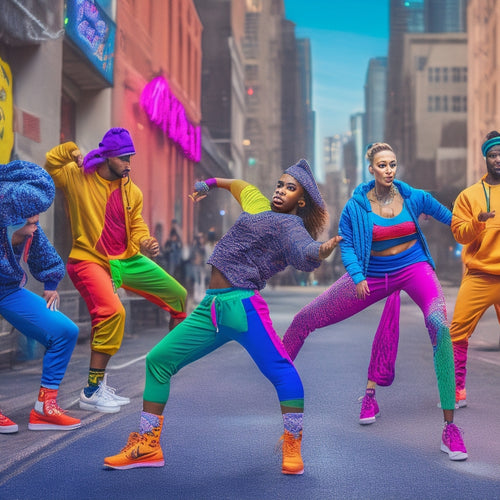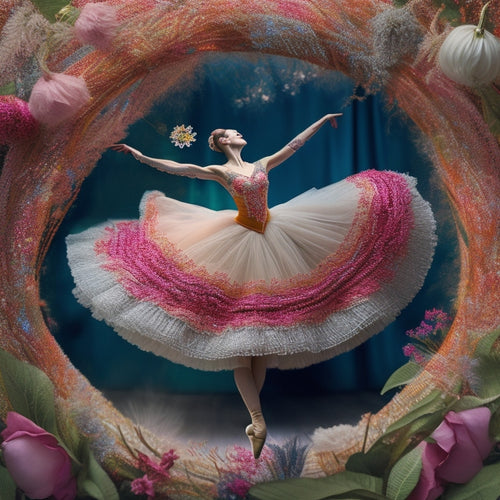Discover the World of Dance: Cultures & Traditions
Share
Dance is a universal language that transcends cultural boundaries, with diverse traditions and styles shaped by the rich cultural heritage of communities around the world. The fundamental elements of dance, including space, time, and force, combine to create a rich tapestry of movement dynamics. As cultural traditions shape the language of dance, symbolic movements express cultural connections, and historical influences mold dance styles. Spiritual expressions in religious practices and cultural heritage preservation are also integral to dance traditions. As we explore the global landscape of dance, we find a kaleidoscope of traditions in motion, each with its unique story waiting to unfold.
Key Takeaways
• Dance is shaped by diverse cultural traditions, conveying meaning and emotion through symbolic movements and gestures.
• Elements of dance, including space, time, and force, are fundamental components of the language of dance.
• Cultural heritage is preserved and expressed through dance, revealing intricate connections between past and present.
• Dance transcends cultural boundaries, reflecting rich cultural heritage and creating a tapestry of expression.
• Historical influences significantly impact dance evolution, shaping styles and traditions across cultures.
Elements of Dance
What are the fundamental components that shape the language of dance, allowing it to convey meaning and expression across diverse cultural traditions?
The elements of dance provide the foundation for understanding the complexities of movement dynamics. Space, time, and force are the primary components that comprise the language of dance. Within these categories, various elements come into play, such as place, size, level, and direction in space, and speed, rhythm, and tempo in time.
Force is comprised of energy, weight, and flow. These elements, when combined, create a rich tapestry of movement dynamics that convey cultural significance. By examining these fundamental components, we can gain a deeper appreciation for the nuances of dance across cultures.
Dance Across Cultures
As we explore the world of dance across cultures, it becomes evident that diverse cultural traditions have not only shaped the language of dance but have also been shaped by it, reflecting the intricate relationships between movement, identity, and cultural heritage.
Cultural connections are woven through symbolic movements, conveying meaning and emotion. Historical influences have molded dance styles, such as the classical Cambodian Court Dance, characterized by slow, hypnotic movements.
Spiritual expressions, like those found in Hasidic Jewish traditions, demonstrate the significance of dance in religious practices. Through dance, cultures express and preserve their heritage, revealing the profound impact of historical influences on the evolution of dance.
Traditions in Motion
Through the lens of cultural traditions, dance movements embody the dynamic interplay between historical influences, social norms, and artistic expression, revealing the complex ways in which cultures negotiate identity, community, and heritage.
In motion, traditions come alive, manifesting as ritual connections that transcend time and space. The nuances of cultural expressions are distilled into precise gestures, postures, and rhythms, conveying the essence of a people.
In Classical Cambodian Court Dance, slow, hypnotic movements evoke a sense of reverence, while in Hasidic Jewish traditions, dance becomes an integral part of worship.
As cultural expressions evolve, they weave a rich tapestry of identity, community, and heritage, illuminating the intricate dance between past and present.
Frequently Asked Questions
How Do Cultural Dance Traditions Impact Social and Political Structures?
Cultural dance traditions profoundly impact social and political structures by influencing power dynamics, as they often reinforce or challenge dominant narratives, and contribute to identity formation by embodying and expressing cultural values and norms.
What Role Does Dance Play in Spiritual or Religious Practices Globally?
Globally, dance plays a pivotal role in spiritual or religious practices, serving as a means of Sacred Rituals, facilitating Divine Expression, and bridging the human and metaphysical domains, as exemplified in Hasidic Jewish worship, Cambodian Court Dance, and various other cultural traditions.
Can Traditional Dances Be Adapted for Modern, Fusion Styles Effectively?
In the domain of dance, the Fusion Frenzy phenomenon enables Cultural Blending, where traditional styles merge with modern elements, yielding innovative, eclectic forms that respect cultural heritage while appealing to contemporary sensibilities.
How Do Dance Costumes and Accessories Reflect Cultural Identities?
"A thousand threads of cultural heritage weave together on the dancer's body, as costumes and accessories transform into Cultural Signifiers, Adorned Bodies, and Ritualistic Attire, reflecting the richness and diversity of cultural identities."
Are There Universal Dance Movements That Transcend Cultural Boundaries?
While cultural nuances prevail, certain dance movements exhibit universality, transcending cultural boundaries through kinesthetic language, as evident in cross-cultural fusions, where shared human experiences and emotions converge, surpassing linguistic and cultural divides.
Related Posts
-

Hip Hop Dance Apparel for Style and Function
Hip hop dance apparel combines style and functionality, so you can move with confidence and flair. Look for breathabl...
-

Unleashing Business Success Through Dance E-Learning
Dance e-learning is revolutionizing business success by making high-quality training accessible to aspiring dancers w...
-

Dance Into Creativity With Ballerina Embroidery Pattern
Ignite your creative potential with the enchanting ballerina embroidery pattern, where artistry meets precision. This...


